Key takeaways:
- Nature serves as a reflection of our emotions, inspiring poetry that connects personal experiences with the natural world.
- Thematic elements of nature evoke universal feelings, facilitating deeper exploration of complex topics like love, loss, and renewal.
- Techniques such as sensory imagery, personification, and natural metaphors enhance the relatability and emotional impact of poetry.
- Personal inspirations from nature, such as walks and observations, enrich poetic expression and foster connections to universal themes of memory and belonging.
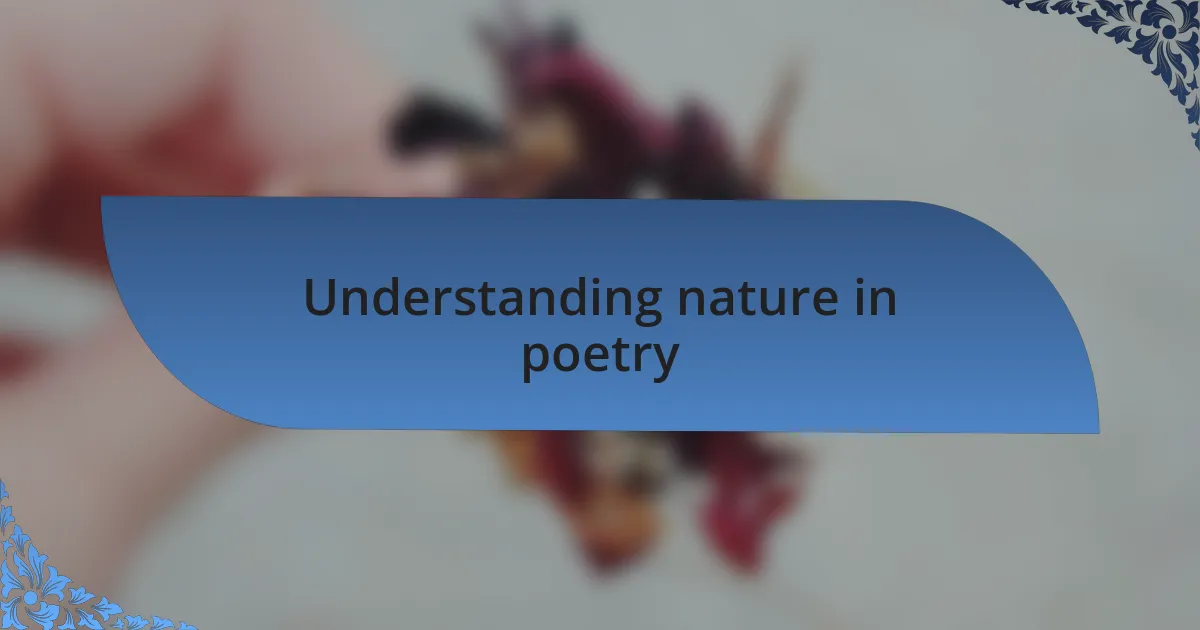
Understanding nature in poetry
Nature holds a mirror to our emotions, often reflecting the subtleties of our experiences in striking ways. For instance, I still remember a moment sitting by a quiet stream, where the gentle whisper of the water resonated with my feelings of calm and introspection. How often do we overlook these moments in nature that can deeply inform our creative expressions?
When I write about nature, I find that it becomes a bridge between my inner thoughts and the outer world. I once penned a poem while hiking amidst towering trees, feeling their ancient wisdom seep into my words. Don’t you find that certain landscapes evoke memories or emotions that demand to be expressed? This connection fuels my passion for weaving nature into my poetry.
Every season brings its own language and lessons, which invite exploration and understanding. I recall a chilly autumn afternoon when the crinkling leaves underfoot reminded me of the transient nature of life. How does the changing environment shape your perceptions? Engaging with these elements allows us to cultivate a deeper appreciation for life, which inevitably enhances our poetic voice.
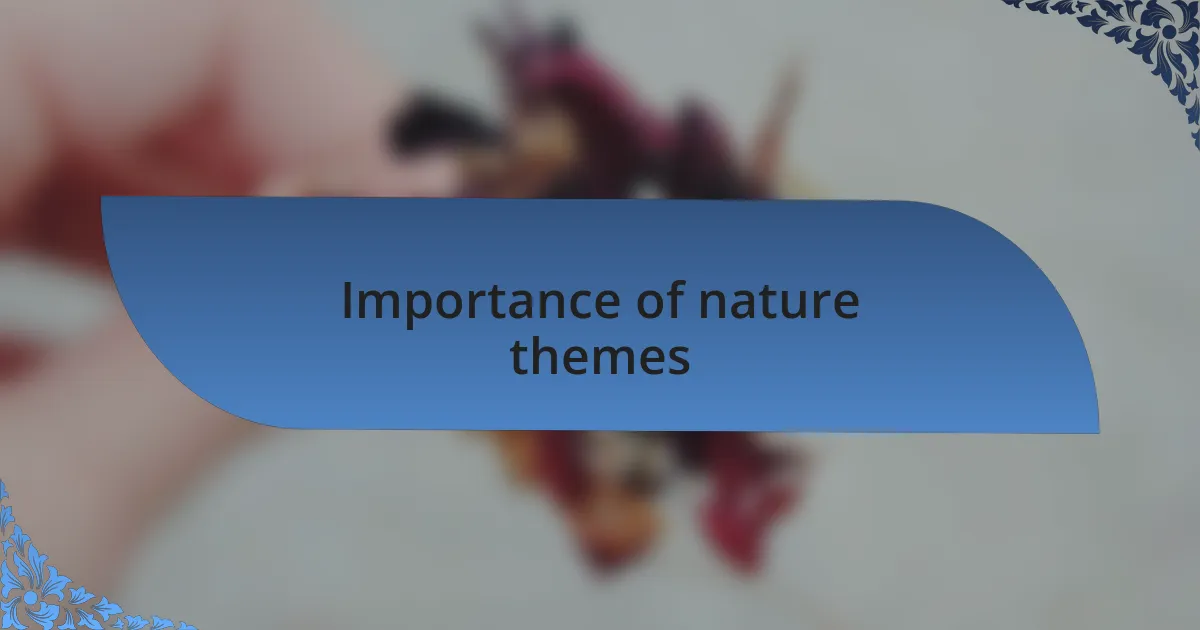
Importance of nature themes
Nature themes in poetry are essential because they evoke visceral emotions and resonate on a personal level. I vividly remember a rainy afternoon when the patter of raindrops against my window sparked a profound sense of nostalgia. How often do the elements of weather inspire our mood and reflections? For me, those moments underscore the interconnectedness of our inner lives with the natural world.
Moreover, utilizing nature allows poets to explore universal themes like love, loss, and renewal in relatable ways. During one of my countless beach walks, I found inspiration in the ebb and flow of the tides, mirroring the rhythms of human relationships. This metaphor—how life has its highs and lows—strikes a chord with many, don’t you think? Through such imagery, I can communicate complex feelings while anchoring them in the familiarity of the environment around us.
Additionally, incorporating nature helps us to remind readers of the beauty and fragility of our world. I once penned a poem standing atop a mountain, surrounded by endless vistas, and felt a rush of gratitude for the earth’s wonders. Isn’t it fascinating how those breathtaking views can evoke not just admiration but also a sense of responsibility for preservation? By highlighting these moments in poetry, we can inspire others to appreciate and protect the delicate balance of nature.
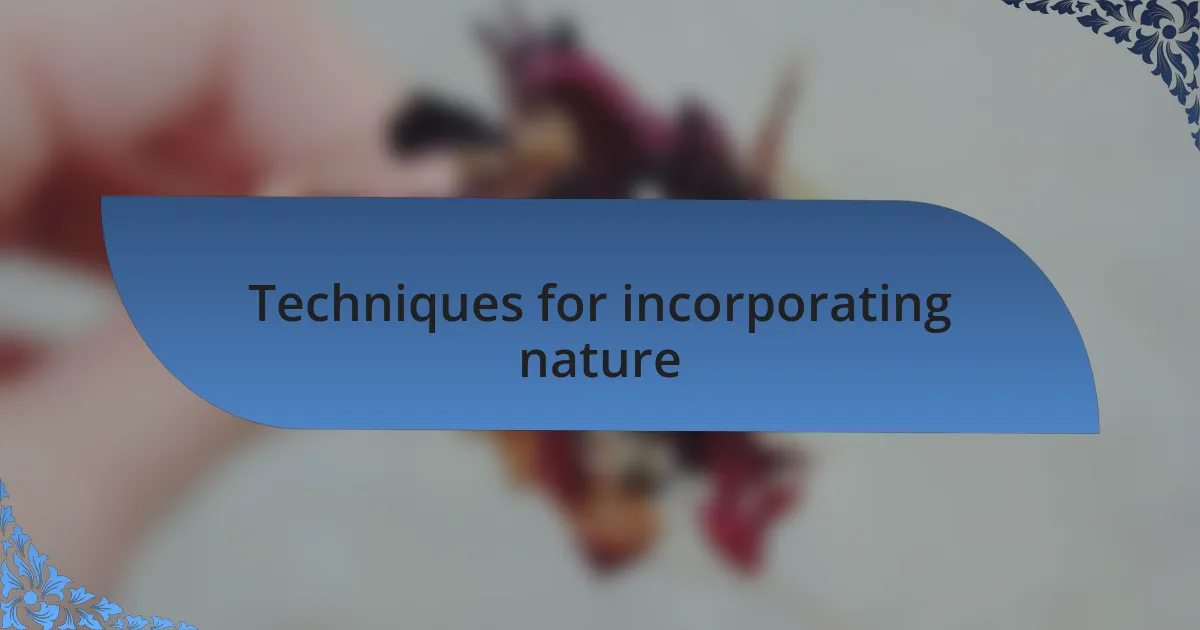
Techniques for incorporating nature
One effective technique for incorporating nature into poetry is through sensory imagery. I recall a moment in my garden, where I became acutely aware of the fragrant scent of blooming jasmine mingling with the earthy smell of soil after rain. Just imagining these scents brings the scene alive, doesn’t it? This vivid sensory approach allows readers to not only visualize the setting but also to experience the emotions tied to those particular moments.
Another technique I often use is personification. By attributing human qualities to elements of nature, I create a more relatable and dynamic environment in my poems. For example, in a piece about a storm, I described the wind as “howling in fury,” which not only paints a picture but also conveys an emotional intensity that resonates with feelings of chaos and struggle. Have you ever felt the wild energy of a storm reflecting your own inner turmoil? That connection deepens the reader’s engagement with the poem.
Lastly, I find that using natural metaphors to discuss abstract concepts can be very impactful. During a quiet evening in the woods, I noticed how the aging tree stood firm against the changing seasons, reminding me of resilience. This metaphor can be powerful, illustrating how we, too, endure and adapt through life’s inevitable changes. Isn’t it interesting how nature mirrors our human experiences in such profound ways? By weaving these elements together, I craft poetry that feels both grounded and deeply relatable.
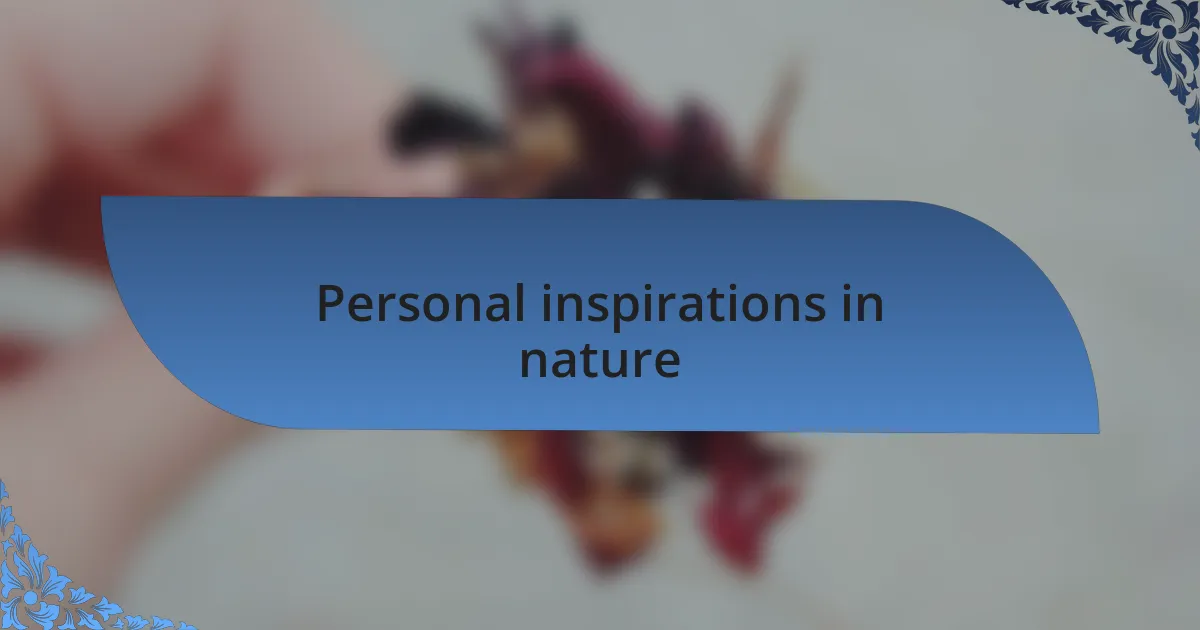
Personal inspirations in nature
When I think of personal inspirations in nature, one vivid memory comes to mind: a solitary walk along a sunlit beach. The rhythmic crashing of waves drowned out my thoughts, allowing me to reflect on my emotions. Did you ever notice how nature often acts as a mirror to our feelings? That tranquility I found in the ocean’s embrace inspired verses about solitude and the longing for connection.
In another instance, one chilly autumn afternoon, I sat beneath a vibrant maple tree, its leaves fluttering to the ground like whispered secrets. With each leaf that fell, I was struck by the beauty of letting go, which sparked lines of poetry centered on life’s inevitable transitions. How often do we resist change only to find peace in acceptance? This exploration of nature’s cycles deepened my understanding and expression of themes in my writing.
I also draw inspiration from the quiet hum of a forest at dusk. The world transitions from day to night, and I can feel the energy shift around me. This moment hangs delicately between light and darkness, nudging me to contemplate the balance of opposites. Have you ever felt that tension before? It’s this interplay that enchants me, pushing me to write about the ever-present contrasts in life, blending joy with sorrow and hope with despair.
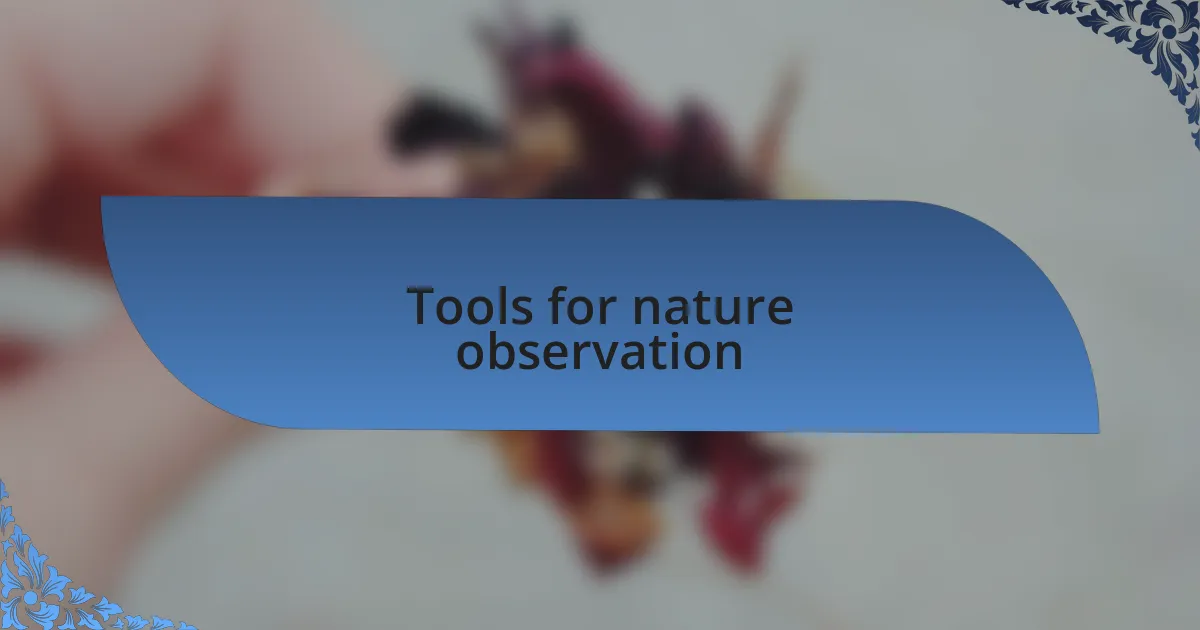
Tools for nature observation
When it comes to observing nature, I rely heavily on my trusty notebook and a simple set of colored pencils. The act of sketching catches my attention more than mere photographs ever could, allowing me to capture not just what I see, but also what I feel in that moment. Have you ever tried to draw a tree and found yourself pondering its growth rings, each one a testament to its resilience? This process transforms a basic observation into a deeper meditation.
I also appreciate using a quality pair of binoculars during my excursions. There’s something exhilarating about getting a closer look at a bird flitting through the branches or noticing the subtle interplay of light on a dew-laden spider web. It invites me to question: what stories does this tiny creature hold? Those details often spark the most heartfelt lines in my poems, reminding me that beauty exists in the smallest of observations.
Another valuable tool in my arsenal is the nature journal. I’ve kept one for years, noting everything from weather patterns to elusive animal behavior. Sometimes, I write early in the morning while sipping coffee, watching how the sunrise paints the sky. Has a moment like that ever felt like a personal gift to you? These entries have enriched my poetry, providing raw material that speaks of moments of wonder, fleeting yet profound, each line a brushstroke in the larger canvas of my experience.
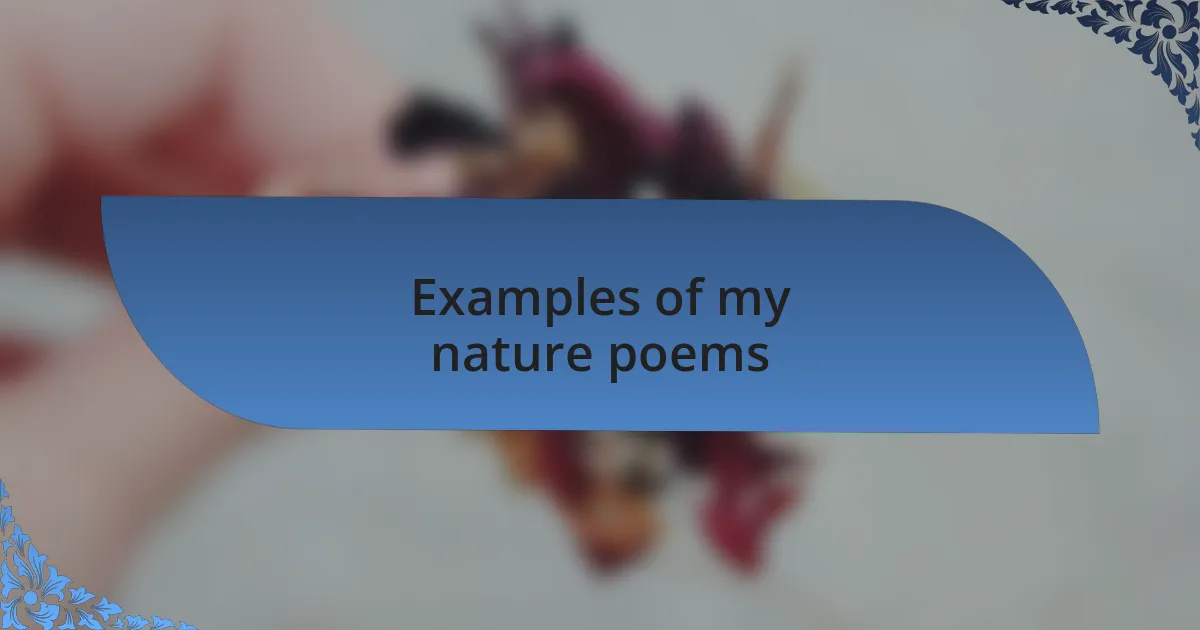
Examples of my nature poems
One of my favorite pieces centers on the first bloom of spring, when the world shakes off winter’s grasp. I recall sitting on a mossy log, pen in hand, as I watched a cluster of crocuses daring to show their faces. In that moment, I couldn’t help but marvel at their courage. Could something so delicate teach us about resilience? Those verses flowed easily, reflecting how nature often holds a mirror to our own struggles and triumphs.
Another poem I wrote explored the sound of rain on metal roofs during a stormy night. It was a cozy moment; I remember curling up with a blanket and letting the rhythmic patter play like a soothing lullaby. I began to ponder—what stories might the raindrops carry from the clouds? This contemplation led to lines that embraced both nostalgia and the sins of forgetfulness, reminding me that every drop is a transient memory, washing the past away while nourishing the earth.
In a recent piece, I depicted an autumn walk through a forest ablaze with color. The vibrant reds, golds, and browns were breathtaking, yet it was the crunch of leaves underfoot that struck me most. I often wonder how many footsteps have shared that same path over the decades. This sensory experience became a metaphor for our own journeys, intertwining with themes of change and loss, capturing the essence of what it means to embrace life’s inevitable transitions.
Reflecting on nature’s impact
Reflecting on nature’s impact often brings me back to a moment on a quiet beach at dawn. The gentle waves lapping at the shore felt like a soft whisper, reminding me that nature has its own way of conveying comfort. In that stillness, I found clarity; how often do we seek solace in the embrace of nature when the world feels overwhelming?
I remember a hike up a local mountain trail, the scent of pine filling the air as I ascended. Each step was accompanied by birdsong, a symphony that seemed to flow with my heartbeat. I began to wonder—how do these natural cadences influence our emotions? For me, that experience opened a door to deeper self-reflection, revealing how nature’s melodies can resonate within us and shape our thoughts and creativity.
In another instance, I was struck by how a simple patch of wildflowers could evoke a sense of nostalgia. As I knelt to admire their beauty, the vibrant colors transported me back to childhood days spent chasing butterflies. It struck me profoundly: can something as small as a flower remind us of who we are and where we come from? This connection fosters a rich emotional tapestry that we can weave into our poetry, tapping into the universal themes of memory and belonging.